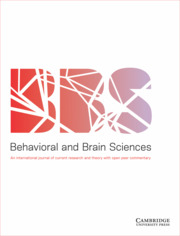No CrossRef data available.
Article contents
Fearfulness: An important addition to the starter kit for distinctively human minds
Published online by Cambridge University Press: 08 May 2023
Abstract
Grossmann's impressive article indicates that – along with attentional biases, expansion of domain-general processes of learning and memory, and other temperamental tweaks – heightened fearfulness is part of the genetic starter kit for distinctively human minds. The learned matching account of emotional contagion explains how heightened fearfulness could have promoted the development of caring and cooperation in our species.
- Type
- Open Peer Commentary
- Information
- Copyright
- Copyright © The Author(s), 2023. Published by Cambridge University Press
References
Decety, J., & Cowell, J. M. (2014). The complex relation between morality and empathy. Trends in Cognitive Sciences, 18(7), 337–339. doi:10.1016/j.tics.2014.04.008CrossRefGoogle ScholarPubMed
de Waal, F. B. M., & Preston, S. D. (2017). Mammalian empathy: Behavioural manifestations and neural basis. Nature Reviews Neuroscience, 18(8), 498–509. doi:10.1038/nrn.2017.72CrossRefGoogle ScholarPubMed
Frith, U. (2001). Mind blindness and the brain in autism. Neuron, 32(6), 969–979. doi:10.1016/s0896-6273(01)00552-9CrossRefGoogle ScholarPubMed
Gonzalez-Liencres, C., Shamay-Tsoory, S. G., & Brune, M. (2013). Towards a neuroscience of empathy: Ontogeny, phylogeny, brain mechanisms, context and psychopathology. Neuroscience and Biobehavioral Reviews, 37(8), 1537–1548. doi:10.1016/j.neubiorev.2013.05.001CrossRefGoogle ScholarPubMed
Heyes, C. (2018b). Empathy is not in our genes. Neuroscience and Biobehavioral Reviews, 95, 499–507. doi:10.1016/j.neubiorev.2018.11.001CrossRefGoogle Scholar
Heyes, C. (2019). Precis of cognitive gadgets: The cultural evolution of thinking. Behavioral and Brain Sciences, 42, 1–13. doi:10.1017/s0140525x18002145CrossRefGoogle Scholar
Heyes, C., Chater, N., & Dwyer, D. M. (2020). Sinking in: The peripheral Baldwinisation of human cognition. Trends in Cognitive Sciences, 24(11), 884–899. doi:10.1016/j.tics.2020.08.006CrossRefGoogle ScholarPubMed
Mineka, S., Davidson, M., Cook, M., & Keir, R. (1984). Observational conditioning of snake fear in rhesus monkeys. Journal of Abnormal Psychology, 93(4), 355–372. doi:10.1037/0021-843x.93.4.355CrossRefGoogle ScholarPubMed
Rescorla, R. A., & Wagner, A. R. (1972). A theory of Pavlovian conditioning: Variations in the effectiveness of reinforcement and nonreinforcement. In Black, A. H. & Prokasy, W. F. (Eds.), Classical conditioning II: Current theory and research (pp. 64–99). Appleton-Century-Crofts.Google Scholar




Target article
The human fear paradox: Affective origins of cooperative care
Related commentaries (28)
A novel(ty) perspective of fear bias
Are we virtuously caring or just anxious?
Beyond the fearful ape hypothesis: Humans are also supplicating and appeasing apes
Conceptualization, context, and comparison are key to understanding the evolution of fear
Cooperative care as origins of the “happy ape”?
Cultural evolution needed to complete the Grossmann theory
Developmental and evolutionary models of social fear can address “the human fear paradox”
Fear can promote competition, defensive aggression, and dominance complementarity
Fear signals vulnerability and appeasement, not threat
Fearful apes or emotional cooperative breeders?
Fearful apes or nervous goats? Another look at functions of dispositions or traits
Fearful apes, happy apes: Is fearfulness associated with uniquely human cooperation?
Fearfulness: An important addition to the starter kit for distinctively human minds
Heightened fearfulness as a developmental adaptation
Heightened fearfulness in infants is not adaptive
Hominin life history, pathological complexity, and the evolution of anxiety
How “peer-fear” of others' evaluations can regulate young children's cooperation
Infants aren't biased toward fearful faces
Is there a human fear paradox? A more thorough use of comparative data to test the fearful ape hypothesis
More than fear: Contributions of biobehavioral synchrony and infants' reactivity to cooperative care
Social learning and the adaptiveness of expressing and perceiving fearfulness
The adaptiveness of fear (and other emotions) considered more broadly: Missed literature on the nature of emotions and its functions
The dark side of fear expression: Infant crying as a trigger for maladaptive parental responses
The human fear paradox turns out to be less paradoxical when global changes in human aggression and language evolution are considered
The power of the weak: When altruism is the equilibrium
The suffering ape hypothesis
Under greater cooperative care, childhood fear is more accommodated, but less warranted
We aren't especially fearful apes, and fearful apes aren't especially prosocial
Author response
Extending and refining the fearful ape hypothesis